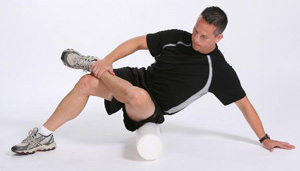Written by Daniel Hayes, personal trainer at Inspire Fitness.
 You may have heard of the term fascia, but few people are clear on what it is or how important it is to their ability to move and exercise. Fascia is an anatomical term referring to a strong connective tissue that surrounds muscle, which is arranged throughout the body like an inter-connected web. Picture this: if you cut an orange in half and examined the inside, you would see a series of string-like fibres separating the orange into wedges. If you looked closely, within each wedge would be smaller fibres that each contain little pockets of orange juice. Much like these fibres in an orange, the fascia in the body is responsible for enveloping and separating our muscles.
You may have heard of the term fascia, but few people are clear on what it is or how important it is to their ability to move and exercise. Fascia is an anatomical term referring to a strong connective tissue that surrounds muscle, which is arranged throughout the body like an inter-connected web. Picture this: if you cut an orange in half and examined the inside, you would see a series of string-like fibres separating the orange into wedges. If you looked closely, within each wedge would be smaller fibres that each contain little pockets of orange juice. Much like these fibres in an orange, the fascia in the body is responsible for enveloping and separating our muscles.
Because fascia envelopes our muscles, when it is tight, it decreases the amount of space your muscles have to move and contract, which in turn decreases your flexibility. Fascia accounts for just under 50% of your flexibility, hence tight fascia leads to a decrease in muscular flexibility. Unfortunately, when you lack flexibility, your ability to perform simple tasks in daily life is impeded. This can be detrimental to your health, as your body begins to compensate and alter your movement patterns in order to execute tasks without pain or discomfort. In doing so, this places undue stress on structures of your body that aren’t designed for these altered postures or cannot handle these loads.
Connections of fascia work and integrate together throughout your body. These are akin to fascial trains. One of these connected fascial lines is known as the Superficial Back Line (SBL). The SBL runs along the entirety of our “back” line, from the bottom of our feet to the top of our neck. If one part of this fascial line is tight, it will cause reduced flexibility throughout the entire connected line, decreasing overall movement in that direction. By releasing tightness in any particular fascia through myofascial release techniques, you increase flexibility through the entire line. For example, poor hamstring flexibility can stem from tight fascia in the bottom of your foot and/or in your gluteal muscle on that same side. Releasing or stretching only the hamstring will NOT alleviate this tightness, as this whole fascial line must be released.
We have established that fascia plays a major role in your flexibility and your ability to move freely and perform exercise. So what can you do to prevent your fascia becoming tight and restricting your ability to move efficiently?
Myofascial release techniques are a common method we use to reduce or release the tightness in fascia. These release techniques can be performed by applying a direct force onto the fascia, to slowly stretch and elongate the fascia and to mobilise adhesive tissues to reduce tightness.
 At Inspire Fitness, we use a number of tools to aid in myofascial release and to ease trigger points within muscle structure. These tools include foam rollers, spikey balls, tennis balls, and various massage balls. By spending five to ten minutes performing specific myofascial release exercises before your workout, you can decrease muscular tightness and increase your flexibility. This will, in turn, improve the efficiency and performance of your exercises, subsequently improving the quality of your training.
At Inspire Fitness, we use a number of tools to aid in myofascial release and to ease trigger points within muscle structure. These tools include foam rollers, spikey balls, tennis balls, and various massage balls. By spending five to ten minutes performing specific myofascial release exercises before your workout, you can decrease muscular tightness and increase your flexibility. This will, in turn, improve the efficiency and performance of your exercises, subsequently improving the quality of your training.
